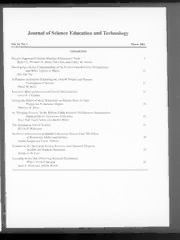
Journal of Science Education and Technology 2003: Vol 12 Table of Contents PDF
Preview Journal of Science Education and Technology 2003: Vol 12 Table of Contents
Journal of Science Education and Technology Vol. 12, No. 1 March 2003 CONTENTS Haptics-Augmented Simple-Machine Educational Tools Robert L. Williams II, Meng-Yun Chen, and Jeffrey M. Seaton Developing a Better Understanding of the Relationship Between Transpiration and Water Uptake in Plants Din Yan Yip A Window on Science: Exploring the JASON Project and Student Conceptions of Science David M. Moss Scientists’ Role in Educational Content Development Carol A. Christian Testing the Effect of Meat Tenderizer on Human Hair: A Class Project for Nonscience Majors Marjorie A. Jones A “Thinking Journey” to the Planets Using Scientific Visualization Technologies: Implications to Astronomy Education Yoav Yair, Yaron Schur, and Rachel Mintz Che Scientist as School Teacher Byron H. Waksman Students’ Achievement in Human Circulatory System Unit: The Effect of Reasoning Ability and Gender Semra Sungur and Ceren Tekkaya Evaluation of a Statewide Science Inservice and Outreach Program: Teacher and Student Outcomes Kimberly H. Lott Learning by the Sun: Observing Seasonal Declination With a Vertical Sundial Judy L. Klein and Adrian Riskin Journal of Science Education and Technology Vol. 12, No. 2 June 2003 CONTENTS Use of the Digital Camera to Increase Student Interest and Learning in High School Biology Denise Tatar and Mike Robinson Maxims to Help Understand the World: Simple Rules to Guide Learning about Geographic Complexity Stephje n S. BI irdsall ty Student Use of Internet Study Rooms for Out-of-Class Group Study in Introductory Biology G. Sokolove, Gili Marbach-Ad, and Judith Fusco Can Scientific Writing Be Creative? Mehrdad Massoudi A Conceptual Change Teaching Strategy to Facilitate High School Students’ I standing of Electrochemistry Mansoor Niaz and Eleazar Chacon Understanding Greek Primary School Children’s Comprehension of Sun Exposure Stylianos M. Piperakis, Vasiliki Papadimitriou, Michael M. Piperakis, and Panagiotis Zisis Searching for Educational Technology Faculty Lloyd H. Barrow Bumble Boosters: Students Doing Real Science Douglas . rolick, Diana M. Schlesselman, Marion D. Ellis, and Day i Vv Brooks Developing and Sustaining K-12 School Technology Innovation through Lottery Grant Awards: A Multiple Case Study Lynne McKnight Herr and David W. Brooks Automated Te David W. Brooks, Diane E. Nolan, and Susan Gallagher Journal of Science Education and Technology Vol. 12, No. 3 September 2003 CONTENTS Teachers’ Perceptions of Teaching Environmental Issues within the Science Curriculum: A Hong Kong Perspective Andre Chi-chung Ko and John Chi-kin Lee Online Training: An Evaluation of the Effectiveness and Efficiency of Training Law Enforcement Personnel over the Internet Joyce M. Schmeeckle Small-Group Interview-Based Discussions about Diffused Shadow Haim Eshach Common Molecules: Bringing Research and Teaching Together through an Online Collection Leah M. Sandvoss, William S. Harwood, Ali Korkmaz, John C. Bollinger, John C. Huffman, and John N. Huffman Connected Chemistry—Incorporating Interactive Simulations into the Chemistry Classroom Mike Stieff and Uri Wilensky Science, Society, and Technology—Three Cultures and Multiple Visions Sumit Bhaduri Solar Village—Educational Initiative for Kids Muhamad Hugerat, Salman Ilyian, Zehava Toren, and Fawzi Anabosi Cookbook Procedures in MBL Physics Exercises Brent Royuk and David W. Brooks Can Computer Use Hurt Science Achievement? The USA Results from PISA Elena C. Papanastasiou, Michalinos Zembylas, and Charalambos Vrasidas CHE Mnet—Structure, Design, and Evaluation of an Online Chemistry Course Sabine Nick, Judith Andresen, Birgit Liibker, and Luzie Thumm Journal of Science Education and Technology Vol. 12, No. 4 December 2003 CONTENTS The Teaching of Science: Content, Coherence, and Congruence ‘odge rW. Bybee “L Tell Me, I'll Find Out” Robert Karplus—A Science Education Pioneer Robert G. Fulle: Science Background and Spatial Abilities in Men and Women Sheila Brownlow, Tamara K. McPheron, and Cheryl N. Acks The Indian Association for the Cultivation of Science: A Tortuous Tryst with Modern Science John Bosco Lourdusamy Community Building Through Electronic Discussion Boards: Pre-Service Teachers’ Reflective Dialogues on Science Teaching Jazlin V. Ebenezer, Frank Lugo, Beata Beirnacka, and Anton Puvirajah Use of Computer Modeling of Site-Directed Mutagenesis of a Selected Enzyme: \ Class Activity for an Introductory Biochemistry Course Marjorie A. Jones, Raymond Shoffner, and Jon Friesen Interdisciplinary Faculty Development Seminars: A Model for Learning Emerging Technologies While Developing Interdisciplinary Partnerships Suzanne Amador Kane Rethinking Course Assessment: Creating Accountability With Web-Based Tools Kent J. Crippen Growth in Students’ Attitudes About the Utility of Science Over the Middle and High School Years: Evidence From the Longitudinal Study of American Youth Rani George Guidelines for Establishing Undergraduate Bioinformatics Courses Jac Gues Learning What It Takes to Teach Science: High School Students as Science Teachers for Middle School Students Evaluation of Short-Term Impact of a High School Summer Science Program on Students’ Perceived Knowledge and Skills Kerry L. Ki Jan A. Moynihan, and Dina G. Markowitz BOOK REVIEW Information Arts: Intersectionos f Art, Science and Technology. By Stephen Wilson Reviewed JonathaDn . Chertok Mental Models and Computer-Based Scientific Inquiry Learning: Effects of Mechanistic Cues yn Adolescent Representation and Reasoning About Causal Systems Danie lhe i Kaplan and John Blac kK Inquiry-Events as a Tool for Changing Science Teaching Efficacy Belief of Kindergarten and Elementary School Teachers Haim Esha
